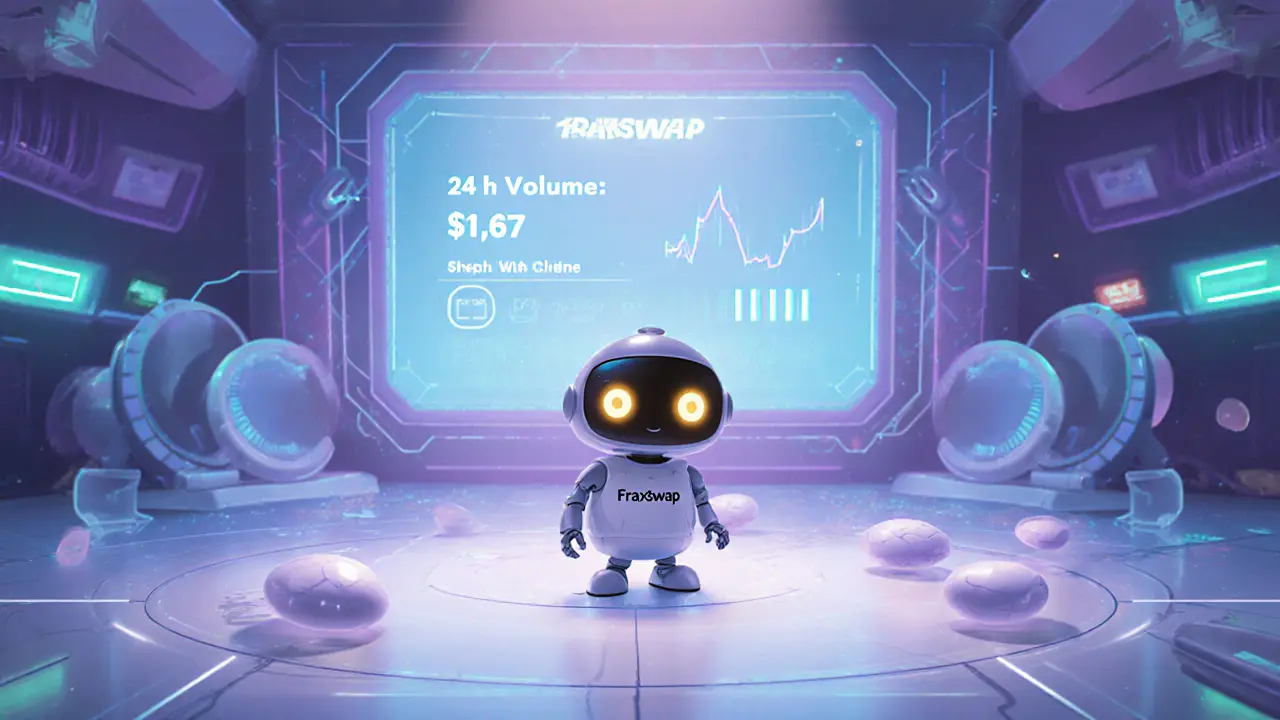Fraxswap (Fantom) DEX Comparison Tool
Comparison with Major Fantom DEXs
| Platform | Avg 24h Volume (USD) | Typical Liquidity (USD) | Main Feature | Swap Fee |
|---|---|---|---|---|
| Fraxswap (Fantom) | ≈ $0.7 | ≈ $10k | TWAMM for time-weighted orders | 0.30% |
| SpookySwap | ≈ $15M | ≈ $150M | Broad token support, LP incentives | 0.25% |
| SpiritSwap | ≈ $8M | ≈ $80M | Dual-reward farms, governance token | 0.30% |
| Beethoven X | ≈ $5M | ≈ $60M | Weighted pools, advanced routing | 0.20% |
How Fraxswap Stacks Up
Volume: Extremely low compared to SpookySwap, SpiritSwap, and Beethoven X. This indicates limited activity and potential issues with liquidity.
Liquidity: Shallow pools mean high price impact for trades. Even small trades can significantly affect prices.
Fee Structure: Standard 0.30% swap fee, similar to SpiritSwap. Lower than some competitors but without additional incentives.
Unique Feature: TWAMM is valuable for institutional users executing large trades, but not practical for retail traders.
When you hear the name Fraxswap, the first thing that comes to mind is a slick, low‑fee DEX on a fast blockchain. But the reality on the Fantom network is a bit more nuanced. Below we break down what the platform actually offers, how it stacks up against the heavy‑hitters on Fantom, and whether its experimental TWAMM feature is a game‑changer or just a fancy gimmick.
What is Fraxswap (Fantom)?
Fraxswap (Fantom) is a decentralized automated market maker (AMM) deployed on the Fantom blockchain. It mirrors the Fraxswap protocol originated by Frax Finance, tying its token economics to the algorithmic stablecoin ecosystem built around FRAX and its governance token FXS. The core of the exchange uses a classic xy=k AMM curve, but it adds a proprietary Time‑Weighted Average Market Maker (TWAMM) layer that spreads large orders over time to curb slippage.
How Does the TWAMM Work?
The TWAMM model is designed for institutional‑size moves or DAO treasury rebalancing. Instead of dumping a multi‑million‑dollar order in one block, the protocol breaks it into tiny increments that execute across many blocks. Each increment trades at the prevailing market price, so the overall average price is smoother. For retail users, the benefit is modest - the feature only triggers when you set a “time‑weighted” order in the UI, which most casual traders never do.
Current Market Activity and Liquidity
Despite its technical ambitions, Fraxswap (Fantom) lives in the shadow of Fantom’s big three - SpookySwap, SpiritSwap, and Beethoven X. According to data from CoinCodex (Sept2025), the platform recorded a paltry $0.67 of 24‑hour volume, with the most active pair being WFTM/FRAX. By contrast, SpookySwap routinely processes tens of millions of dollars daily. The low volume translates into thin order books, meaning even modest trades can suffer noticeable price impact.
Fee Structure and Yield Opportunities
The protocol charges the standard 0.30% swap fee, which is automatically distributed to liquidity providers (LPs). Unlike some competitors, Fraxswap does not currently advertise extra incentive programs or native token rewards (e.g., "farm" tokens). LPs therefore earn only the share of swap fees proportional to their stake in a pool. Because the pools are shallow, fee returns can be erratic - some days you might see a double‑digit APR, other days almost zero.
Comparing Fraxswap (Fantom) to Other Fantom DEXs
| Platform | Avg 24h Volume (USD) | Typical Liquidity (USD) | Main Feature | Swap Fee |
|---|---|---|---|---|
| Fraxswap (Fantom) | ≈ $0.7 | ≈ $10k | TWAMM for time‑weighted orders | 0.30% |
| SpookySwap | ≈ $15M | ≈ $150M | Broad token support, LP incentives | 0.25% |
| SpiritSwap | ≈ $8M | ≈ $80M | Dual‑reward farms, governance token | 0.30% |
| Beethoven X | ≈ $5M | ≈ $60M | Weighted pools, advanced routing | 0.20% |

Who Might Actually Use Fraxswap (Fantom)?
The platform’s niche is clearly aimed at two audiences:
- DAOs and institutional treasuries that need to execute large swaps without moving the market too much. The TWAMM can spread a $1‑million order across several hours, keeping the average price close to spot.
- Developers building on top of the Frax Finance ecosystem who want on‑chain price feeds that are tightly tied to FRAX stability mechanisms.
For a casual retail trader looking to swap a few hundred dollars of WFTM for FRAX, a more liquid DEX like SpookySwap is usually the smarter choice.
Security and Audits
The smart contracts are open‑source on GitHub and are reviewed periodically by the Frax Finance team. However, a formal third‑party audit report specific to the Fantom deployment has not been published publicly. The broader Fraxswap codebase has passed audits on Ethereum, but cross‑chain deployments can expose subtle differences, especially around the TWAMM logic.
Pros and Cons - Quick Reference
- Pros
- Innovative TWAMM feature for large, low‑impact orders.
- Deep integration with the FRAX stablecoin ecosystem.
- Low transaction fees thanks to Fantom’s sub‑cent gas costs.
- Cons
- Extremely low daily volume and liquidity.
- Scarce community support and limited documentation for Fantom‑specific usage.
- No native incentive programs for LPs, leading to volatile fee yields.
- Absence of a public audit for the Fantom contracts.
How to Get Started - Step‑by‑Step
- Install a Web3 wallet (MetaMask, Trust Wallet, or a Fantom‑compatible hardware wallet).
- Switch the network to Fantom Opera (chain ID 250).
- Load a small amount of FTM to cover gas.
- Navigate to the Fraxswap (Fantom) UI (
app.fraxswap.com- the site automatically detects the Fantom network). - Select a pair (e.g., WFTM/FRAX), enter your amount, and confirm the transaction.
- If you want to provide liquidity, click the “Add Liquidity” tab, deposit equal values of both tokens, and approve the smart contract.
Remember: because pools are shallow, a $500 trade can already shift the price by a few percent. Always double‑check the slippage tolerance setting before confirming.
Future Outlook
Fraxswap’s roadmap for the Fantom network is vague. The broader Frax Finance team is actively working on cross‑chain bridges and new stablecoin mechanisms, but there are no announced upgrades specifically for the Fantom AMM. If the TWAMM gains traction on Ethereum or other Layer‑1s, the Fantom deployment could benefit from shared code improvements. Until then, users should treat the platform as experimental - useful for niche institutional trades but not a primary destination for day‑to‑day swapping.
Frequently Asked Questions
Is Fraxswap (Fantom) safe to use?
The contracts are open‑source and have been audited on Ethereum, but a dedicated audit for the Fantom version is missing. The low liquidity also means price manipulation is easier for large trades. Use small amounts and treat it as experimental.
What is the advantage of the TWAMM?
TWAMM spreads a big order over many blocks, reducing slippage. It’s mainly useful for DAOs or institutions that need to move millions without shocking the market.
How does the fee compare with other Fantom DEXs?
Fraxswap charges a flat 0.30% fee, similar to SpiritSwap and slightly higher than SpookySwap’s 0.25% fee. Beethoven X offers a lower 0.20% fee but compensates with more complex routing.
Can I earn extra tokens by providing liquidity?
Currently Fraxswap does not run additional LP incentive programs. Earnings come solely from the 0.30% swap fees, which can be volatile due to low traffic.
Is there a way to trade without paying gas?
No. All transactions on Fantom require a small amount of FTM for gas. The cost is usually a fraction of a cent, but you still need to hold some FTM in your wallet.
Bottom line: Fraxswap (Fantom) shines when you need the TWAMM’s slow‑trade capability, but for everyday swaps the platform’s thin liquidity makes it a risky choice. Keep a small amount of FTM on hand, test with tiny trades, and only consider larger moves if you truly need the time‑weighted execution.







Write a comment